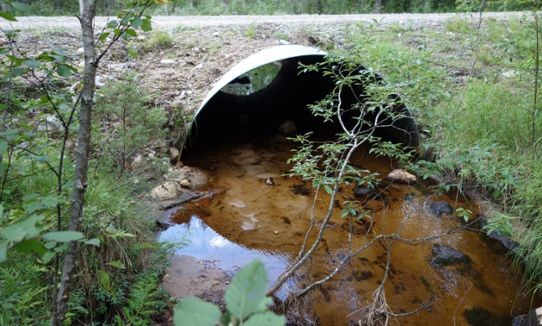Throughout history, mankind has used rivers for transportation, fishing and hydroelectric power. Major changes made recently, such as the conversion of watercourses for log driving and the expansion of hydro power, have impacted the watercourses and natural habitats have disappeared.
Climate change
Climate change will contribute to Sweden partly becoming warmer and wetter. A warmer climate means more precipitation, which increases the risk of flooding from lakes and rivers. Cleared rivers mean that natural flood areas have vanished and the water’s speed has increased.
Converted, straightened rivers mean that water speeds increase, which increases the pressure on many road culverts at the same time that nutrients are carried out into the Baltic Sea. In Sweden, there is on average one road intersection for every two kilometres of a river, which means that incorrectly designed road culverts are an increased risk that the road network will be damaged by floods.

ReMiBar project
The ReMiBar project (2011-2016) aimed to fix incorrectly designed road culverts and dams in Norrbotten and Västerbotten counties. This makes it possible for fish and other species to be able to migrate and use previously closed off habitats. The project also contributes to preventing the road network from being damaged by flooding as the new road crossings with their larger dimension better guide high water flows. This is a kind of ecosystem-based climate adaptation.
Results
In total, 304 migration obstacles were fixed in five catchment areas. The results were that the catchment areas are now free on around 1,700 km on an area 67 km2. This reduces the risk of damage to the road network as a result of flooding at the same time that it benefits aquatic and land plants and animals. These measures were implemented in the rivers Ängesån, Råneälven, Varjisån, Sävarån and Lögdeälven. The restoration was done both manually and by machine. See film: ReMiBar - free migration routes in rivers
Financing
The project was financed by the European Commission through the Life programme. ReMiBar (2011-2016) had a budget of SEK 80 million; the EU financed half and the other half was financed by Swedish authorities, where the Swedish Agency for Marine and Water Management and the Swedish Transport Administration were the largest financiers.
Evaluation and future visions
In total, another 3,691 migration obstacles were inventoried (2018) that need to be resolved in Norrbotten and Västerbotten.
More examples of climate adaptation
This is one of many examples of climate adaptation. There are more in the collection of ideas being built up by the Swedish National Knowledge Centre for Climate Change Adaptation at the Swedish Meteorological and Hydrological Institute (SMHI). The collection of examples has the aim of sharing experiences and providing ideas to everyone who works with climate adaptation. Examples describe concrete measures and challenges in several subject areas. They show how different actors have worked to adapt their activities to the climate changes that are already being noticed today and those that we cannot prevent in the future.